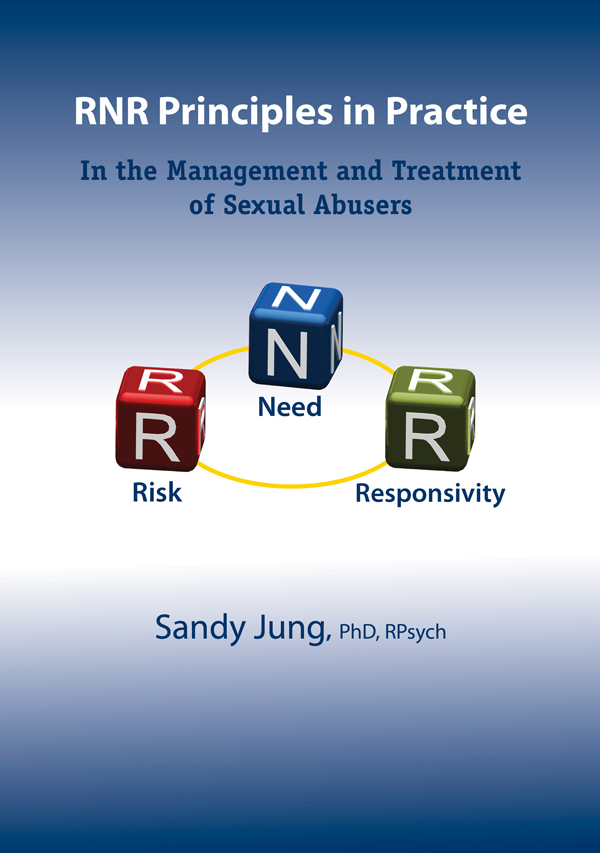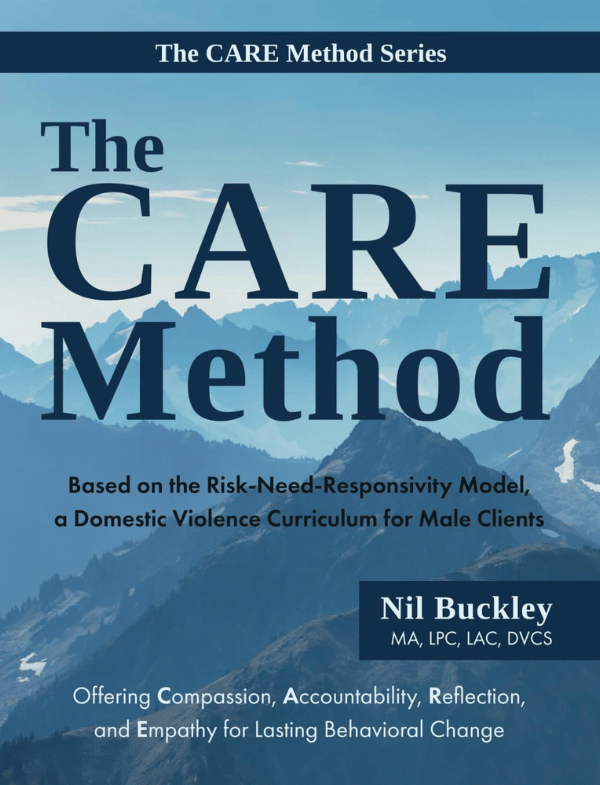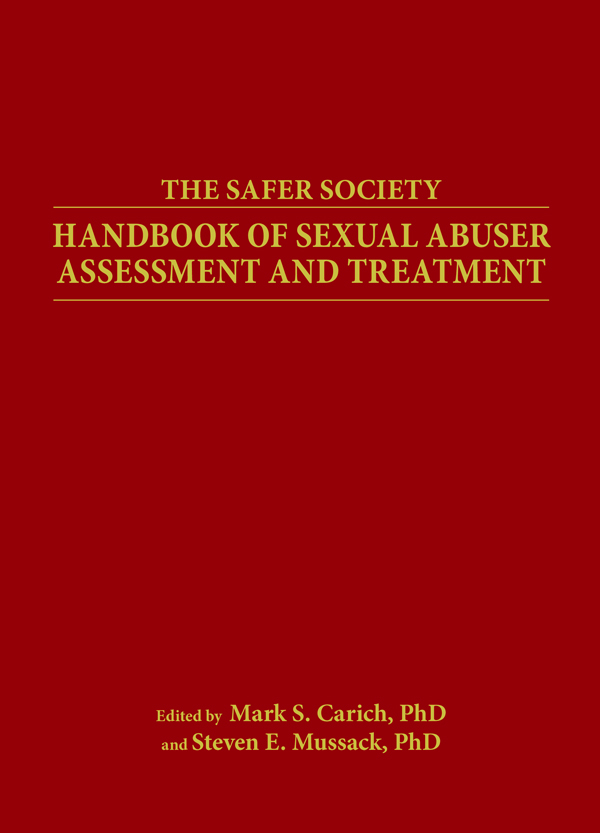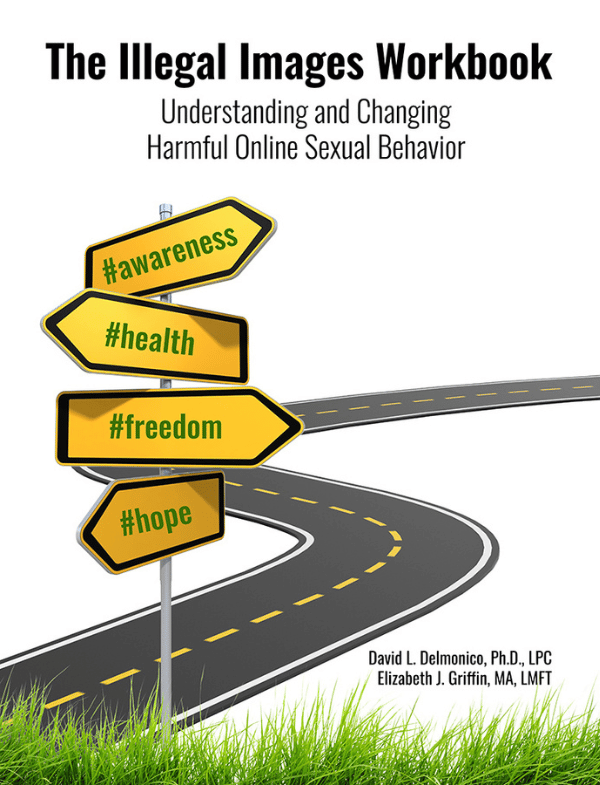Home / Shop / For Adult Clients / Professional Books for Working with Adult Clients
RNR Principles in Practice

- Description
- Specifications
RNR Principles in Practice
In the Management and Treatment of Sexual Abusers
by Sandy Jung
“Use what you know works” - Andrews and Bonta, 2010
Andrews and Bonta’s Risk-Need-Responsivity model is what works. RNR Principles in Practice is about how to use what works.
RNR Principles in Practice guides clinicians, administrators, and supervisory agents through the application of the RNR model and provides practical tools for effectively implementing this model.
The book begins with an overview of the expanded RNR model and the research supporting the effectiveness of this overarching framework for assessment and treatment. Then, Dr. Jung dives into each principle of the model and recommends methods of implementing each principle.
Below you will find each of the principles and a few examples from the book.
Risk Principle:
Match the level of service to the person’s likelihood of reoffending. The principle is based on evidence that providing a higher dosage of treatment to clients who have been assessed to have moderate-to-high reoffense risk is most likely to be effective. Conversely, providing a higher dosage of treatment to lower risk offenders can actually result in an increase in risk.
How Exactly Do You Assess Risk?
Jung addresses the advantages and disadvantages of the typical method of assessing the risk level of people with histories of sexual offending—unstructured clinical judgement—and suggests tools that can increase the reliability of these judgments. One of these is the SVR-20 V2, a 20-item checklist of risk factors for sexual violence. Others covered in this book are the Violence Risk Appraisal Guide, the Static-99 and RRASOR, the Historical Clinical Risk-20 guide, and the Sexual Violence Risk-20 guide.
Jung provides detailed case studies on how to use these measures in practice.
Need Principle:
Assess each person’s criminogenic needs (or dynamic risk factors) and then target these in treatment. Risk factors include antisocial cognitions, a history of antisocial behavior, and substance abuse, among others.
How Exactly Do You Assess Criminogenic Needs?
Jung reviews the “central eight” risk factors that have been empirically demonstrated to predict recidivism and the two key domains associated with sexual recidivism: deviant sexual interests and antisocial behavior. But these well-known eight factors aren’t the only ones to be considered. There are also nine “psychologically meaningful” risk factors to be considered, such as sexual preoccupation, lifestyle impulsivity, and negative social influences. Jung provides a background on these factors proposed by Mann and his colleagues (2010).
Also covered in this section are suggestions on the use of “rolling groups” to assess criminogenic needs.
Responsivity Principle:
Tailor intervention to the motivation, abilities, and strengths of the individual who has sexually abused.
How Exactly Do You Assess Treatment Motivation?
One of the many strengths of Jung’s 174-page book is the abundance of references to validated tools that can be used for each principle of the model. You are probably familiar with some of them.
- Symptom Checklist-90—Revised [SCL-90-R]
- Sex Offender Treatment Intervention and Progress Scale [SOTIPS]
- Psychopathy Checklist—Revised [PCL-R]
- Treatment Readiness scale [MSI-II]
- Stages of Change Questionnaire
- Values in Action Inventory of Strengths [VIA-IS]
- Violence Risk Scale Sexual Offense Version (VRS-SO) (which includes a responsivity scale).
Jung points out that one of the key components of any successful therapeutic intervention is the need for a “therapeutic alliance” between therapist and client. This can be challenging for clinicians dealing with people with histories of sexual offending. Here, too, suggestions are provided to help therapists develop a rapport and exercise empathy with adults who commit sexual offenses without endorsing their crimes.
Case Studies, Field Notes, Reflection Exercises, and Supplemental Materials
Throughout Jung’s book, readers will find case studies drawn from the author’s direct experience treating individuals with a history of committing sexual offenses in both individual and group settings. These case studies often highlight not “ideal cases” but rather the real-world challenges faced by the author.
Finally, included with your purchase of RNR Principles in Practice are printable versions of two tools clinicians can use to assess the responsivity level of their clients, and a version of table 4.1, the “responsivity checklist” to help in the process of auditing existing programs to gauge how well they adhere to the RNR model.
"In RNR Principles in Practice, Sandy Jung has written a smart and accessible “how-to” guide for putting the empirical rubber of the “what works” literature to the clinical road. This book is a must-read for clinicians and administrators who wish to develop an empirically supported treatment program, while simultaneously making the best use of limited program resources." - Liam Ennis, Ph.D., R.Psych, Integrated Threat and Risk Assessment Centre, Edmonton, Alberta, Canada
Make RNR Work for You
With 23 pages of references, this comprehensive resource on the application of RNR principles to everyday practice will prove invaluable to your practice or organization.
Earn CE Credits with GIFR! https://www.gifrinc.com/course/rnr-principles-practice/
References: Andrews, D. A., & Bonta, J. (2010). Rehabilitating criminal justice policy and practice. Psychology, Public Policy, and Law, 16(1), 39–55. https://doi.org/10.1037/a0018362
Enjoyed this book?
Train with Sandy Jung On Demand!
Click here to learn more.
ISBN: 978-1-940234-07-6
paper | 184 pages
Order#: WP177
Price: $32.00




